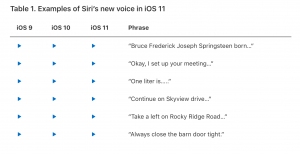Ideas don’t mean anything if they’re not shipped.
The universe doesn’t care about excuses as to why you didn’t ship it. The universe doesn’t care if House of Cards was on. It doesn’t really care about any excuse that you may have.
But the universe does care if you ship your idea and share it.
An idea must be shipped; it may not be polished, but if it is not shipped, then the world will not benefit from your idea.
And often, we need to ship in order to really understand the original intent behind the idea, to see how it is interpreted, to uncover any unintended consequences, and to see what the world view is like once the idea becomes a reality.
I really liked the discussion Kevin Kelly had, where he talked about the future of AI. He said that we won’t be in the world thinking ‘this is AI and this is AI’, rather AI will surface around ideas and products. Some present examples that have already emerged are Amazon’s Alexa and weather applications.
That is the purpose of names and brands: to help us to understand what something is or what does; but until we ship, it doesn’t have a name, it is just a concept.
As humans, we are unhappy when we don’t create.
I had the pleasure of meeting Michael Gerber a while back. I asked him what the secret is to successfully running a business. He answered that people get upset, fatigued, and stressed when they are not creating. When we are merely managing things or “spinning plates,” we don’t get that feeling of accomplishment.
That is why shipping is so important, because we’ve brought something new. It’s what we are good at: creating things, things that go on to change the world around us for the better.
We have too many bosses.
I really like this point. We as a society currently have 40% more “bosses” than we used to have. More bosses who are managing things. Bossing, rather than creating. We don’t need more bosses, we need less, and we also need more freedom.
The tools for creation are more accessible and greater in quantity than ever before.
Each year, the tools available to us become more and more sophisticated. Want to create a home delivery business from your kitchen table? Use the Uber API. Want to instantly reach millions of people? You can do that from anywhere in the world by using Facebook, Google, Twitter… the list goes on. The power of the tools that we have at our finger tips is greater than ever before.
Heck, I recently met a 9-year-old named Cole who had already submitted multiple… MULTIPLE… applications to the App Store. Cole gets it.
There is a valley of death.
There is a deep valley of death in the center of shipping big ideas. I have seen it discussed in “Crossing the Chasm”, “Self Reliance”, and “Quit” by author Seth Godin. If you find that you are not seeing your projects through to the extent that you should, you may want to give these books a read.
In essence, you merely need to overcome the inertia that has built up as you have gone through with the shipping of the idea. A few tricks include:
Clear the runway
Clear everything off of your schedule and solely focus on shipping the idea. Stay up late, get up early, turn off your phone and the internet, put music on. I find that even 3 hours of solid attention is enough to get an idea back on track to be shipped.
Slim the idea down
Remove or kill off components of the idea that are proving onerous. Try to solve a simpler version of the problem. As creators, we tend to over-complicate. Therefore, this is actually a constructive part of the process: shipping a slimmed down version of the product.
Get help
If something isn’t moving because of YOU, and it is something that someone else can do, have them do it. It may only by temporary, it may be permanent, but see above: until the idea ships, it doesn’t mean anything.
Leading & Developing Shipping as Culture
In everything that you do as a leader, you lead by example. In order to instill shipping as a culture, you need to do a few things.
Give permission for ideas to be unpolished
People fear that an unpolished idea may reflect badly on them and hurt their career. Implicitly give permission by shipping a few unpolished ideas yourself. Kill the ideas that you shipped that didn’t work, and be open about it. This is not about ego, it is about getting out of the way so that the idea can come into the world.
Be open to fresh ideas and allow you team to nurture and ship them. Let the unintended consequences, and resulting learning opportunities, come to pass.
Ground ideas in purpose
All shipped ideas must have a clear purpose. If I’m trying to solve X through Y, sharing the purpose allows for other ideas to come to the table and also ensures that those ideas are directionally in align with what your company is trying to achieve.
Make shipping systematic
Keep it as part of KPIs, part of the operating DNA of the company. Set aside time for brainstorming new ideas and the resources available for shipping those ideas. Your aim here is to make this habitual, so it becomes a way of life within your company. Shipping ideas should be ‘just how things are done’.
And finally, embrace the fact that you are always wrong. In business, our aim is to be less wrong tomorrow than we are today. Ideas that didn’t worked a year ago may work now. It’s only by shipping ideas that we move forward.
